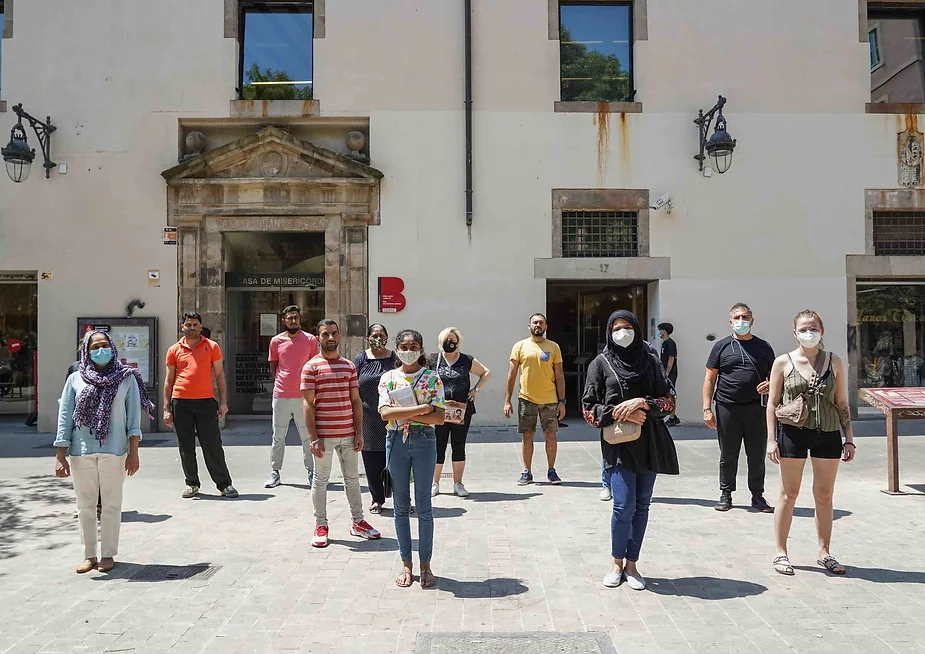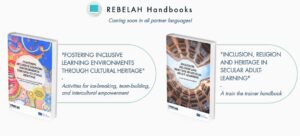
The REBELAH project was launched in 2020 by a consortium of six organisations from Spain, France, Hungary, and The Netherlands with the aim of providing adult educators with creative tools to foster inclusion, diversity and non-discrimination. For this, REBELAH harnessed the power of cultural heritage.
Now that the project has been completed, the consortium will publish two books reflecting the work of these two years: “Fostering inclusive learning environments through cultural heritage: Tool-kit for adult trainers” and “Inclusion, religion and beliefs in secular adult learning environments: a train the trainer handbook.”
In this interview with Todd Weir, we talk about the project development, the idea of diverse heritage and the relationship between heritage and identity. Weir is Director of the Centre for Religion and Heritage at the University of Groningen, an FRH member, and a partner of the REBELAH project.
Could you give us a brief overview of the REBELAH project? What were the goals and what activities you have developed as part of it?
At the Centre for Religion and Heritage, we had been interested in the question of diversity and heritage for some time already. We have developed with FRH an important conference in 2019 “Religious Heritage in a Diverse Europe”. That was a major conference, combining both academics working in the field of heritage and also organisations. We are now about to publish the results of this conference, again with FRH and our other partners, in a Handbook for Religion and Heritage in Contemporary Europe with Bloomsbury press. This book has contributions by some 50 authors and represented the state of the art on the subject of religion, heritage and diversity in Europe.
Nearly three years ago, just as the covid pandemic was starting, we were approached by a consortium of creative organisations that had worked together in a European framework to develop techniques for adult education. Adult education means, in this case, is working with communities that are often disadvantaged, so it could be unemployed, people with disabilities, immigrant groups, etc.
The question that arose for these creative organizations was how to bridge the gap between adult trainers (often with a European background, more Christian) and the populations that they’re serving (more religious, many of them Muslims nowadays). They came up with the idea of using heritage as a means for people to engage in dialogue across religious and cultural divides. Under the leadership of La Xixa, a Barcelona-based organization that works with the methods of Theater of the Oppressed, we put together in the proposal to the European Union Erasmus + call, and we were successful.
We just ended this two-year project, to which we gave the name REBELAH, which is an acronym for REligion, BEliefs and LAicity in cultural Heritage.
How many countries have been involved in this project?
The project consists of six partners. From Barcelona, Spain, alongside the theatre company La Xixa Teatre is the Muslim community group called Ibn Battuta Foundation; from Hungary, Kepes; we have a group in Paris called Elan Interculturel; and then the Centre for Religion and Heritage works together with our Dutch partner Storytelling Centre in Amsterdam.
What kind of activities have you developed in the project to use heritage as a means to promote inclusion?
Well, the topic of the project is a big challenge. Since we have now the FARO convention (Convention on the Value of Cultural Heritage for Society of the Council of Europe), the idea of “inclusive heritage” is widely accepted. This is a good idea, of course, but how do you actually implement it? What I learned from engaging with these creative organisations was the importance of using imaginative techniques, such as theatre and performance, to help people from different backgrounds make their own “heritage meaning”.
La Xixa for example is a theatre company and they do a lot of work with different populations where they get to perform dramas about heritage. These techniques can be used to allow learners to challenge the dominant heritage discourses circulated by national heritage organisations, such as for example national museums. Until recently, such institutions tended to represent the heritage of dominant groups, which led minorities to often have trouble presenting themselves in that space. La Xixa had their classes improvise scenes where they actually acted out the tension between weaker and more powerful social groups.
The group in Amsterdam works with storytelling, in which they help people tell stories about their own personal heritage and articulate them in a classroom. The class functions as a mini public sphere, and telling their history there helps people feel connected and heard.
How effective are such methods of acting out tensions and making new connections via heritage?
Well, we participated ourselves in many of these workshops, and what I found so very moving was that I was actually physically engaged with my body, with my voice in these activities. It’s a bit different for an academic, who is used to just thinking about something or reading something. Also, in the social setting, you immediately get confronted with different points of view. Because in a classroom there are different points of view; that is a lesson in itself.
We were piloting these techniques for use in the classroom so we were really exploring and experimenting with them. I couldn’t say overall what the difficulties may be. That will have to be for people that try to implement this finally in the classroom.
FRH held a masterclass in April this year on the theme of “living religious heritage”. Professor Ioannis Poulios talked about how a heritage site is connected to different communities at the same time and has a different relationship with each of them. Did the REBELAH project also explore the connection of these minority groups with cultural heritage and their identities?
Yes, for example, in one workshop that we had in Barcelona, we were guided around the former Jewish quarter by the heritage organization Mozaika, which told us about the story of the Jewish Community and how, in a sense, its heritage has been forgotten after the Jewish community had expelled from Spain in 1492. So for Jews now living in Barcelona, it was important through the heritage work, to be able to reconnect to the past of Barcelona. Walking the city and seeing the sites and talking about the monuments and the buildings was an act of establishing themselves in the city again.
We tried something similar in Amsterdam, where we developed a Muslim Heritage trail. In this pilot project we created an app for a route one can walk in East Amsterdam. The walkers can stop, click on a site, whether a mosque or museum, and then hear a recording of somebody, often a person with a Muslim background, living right there, who tells the story of the building, or shares their memories about their childhood linked to that heritage.
So, here too we are again about linking, in a very specific way, people’s communities with their cultural heritage.
In one of your articles about minority heritage you speak about the pluralisation of heritage from the top and from below. What does this exactly mean?
The majority of funding still goes to nationally established heritage organisations: big cathedrals, big museums, castles and so on. So one way of integrating a more “diverse heritage” is to go to those institutions and diversify from the top. For example, one can go to the Rijksmuseum in Amsterdam and create a route through the museum collection that highlights evidence of the Muslim or Jewish or Christian minority in Dutch history.
But we also have pluralisation from below, for instance, with our heritage trail in Amsterdam we wanted to have the voices of the local community there and the group Storytelling set about co-creating that trail with them. This is working from below.
I think heritage activists have to work from both directions. An organisation like FRH is particularly good at heritage from the top, because of the way it networks internationally and works through European institutions. However, we also need to pay attention to grassroots heritage efforts.
Are there grassroots efforts towards a more diverse heritage a generalised trend in Europe now? Is European society demanding a more complete picture of their heritage?
It is certainly happening Europe-wide. You know, usually, someone has an original idea, so the thing starts in different locations and spread. For example, our Muslim heritage trail in Amsterdam was inspired by what Tharik Hussain was doing in the UK, in fact, we brought him into our project REBELAH for his expertise. At the opening of our Amsterdam trail, the initiator of Moslimarchief, a new initiative from Rotterdam came, so perhaps the example of Tharik Hussain can spread further.
I do think these grassroots effort is Europe-wide, but obviously, there have to be community organisations that make it happen, and that probably doesn’t exist everywhere.
Are heritage organisations becoming more aware of the need for showing the diversity of heritage because they have a more diverse staff or because representing the heritage of minorities and underrepresented groups is now a trend?
I think multiple things are happening at the same time. Obviously, since the 1990s the question of immigration in Europe has been a central political question. We are seeing immigrant groups now in the third or fourth generation having their own educated intellectuals in the national traditions of The Netherlands. This means that you have now people of all those communities who can articulate quite clearly the need for their heritage to be represented. So that is one thing, communities of former immigrants are asking for their heritage to be presented.
At the same time, you have state officials looking at their diverse populations and thinking, “how do we create a harmonious society which allows pluralism but also unity?” State organisations also look at heritage and say “this is a good field to establish some kind of communication between diverse communities. ” As a consequence, state actors are now involved in pushing and funding inclusive heritage practices.
Finally, you have the elites who run heritage organisations, who have collectively adopted what you might call an ethics of inclusion. This comes from multiple directions: it is influenced by what is happening in the United States with the Confederate memorials, the debates over the European slave trade, and colonialism. All of these things are changing the ethics of running heritage institutions.
To conclude with this interview, can you tell us about the next steps in the REBELAH projects?
We have produced two handbooks for adult educators that will be published soon. These are open access and can be downloaded from the web. I am hoping that they will be circulated and in use because they are free and they are fun publications with games and techniques that any heritage organisation can use to work creatively with heritage. The activities in the book can help to make heritage exciting, especially for young people who often find it a bit dull. These creative activities may help break down this resistance young people feel towards old buildings.
I am hoping that FRH members will find these books particularly interesting because all heritage organisations are involved in education and the need to excite new audiences for Europe’s material and immaterial religious heritage.
In terms of the future, we are very keen on this topic of minority heritage. We would like to work on it with FRH and the network of partners that we have in Europe. Many are interested in continuing this type of creative approach to minority heritage. We have Muslim and Jewish heritage trails emerging across Europe and it seems like a nice metaphor for trying to build connections between minority groups and established heritage organisations and between creative organisations and universities. So this is what I hope we will do next.






Follow us: